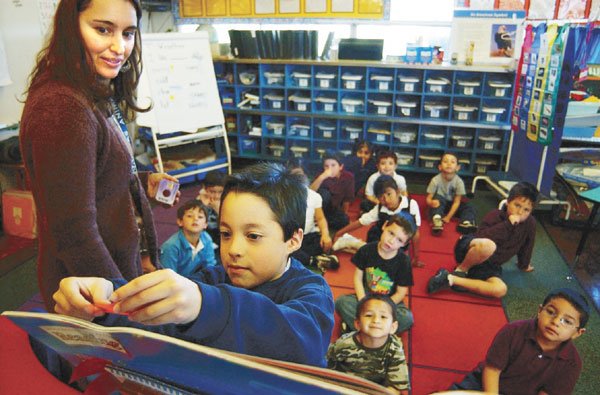Las Animas Elementary School bilingual education program will be
expanded to South Valley Middle School for the upcoming school
year
Gilroy – Sharon Watkins doesn’t speak another language besides English. Neither do her three oldest children.
So when the Gilroy mom first heard about the district’s Dual Immersion program she was immediately sold.
“I’ve always wanted my kids to be bilingual so I just jumped on it,” Watkins said.
But the Spanish/English program, which her daughter began five years ago at the now defunct San Ysidro Elementary School, turned out to be even better than she had envisioned.
“I wanted bilingual and I got bilingual, biliterate,” Watkins said.
And Watkins’ daughter is only one of more than 200 students reaping the benefits of the bilingual program. What began as a pilot with 20 kindergartners at San Ysidro during the 2000-2001 is now available to all students attending Las Animas Elementary School and beginning in the fall will also be offered at South Valley Middle School.
In 2002, when San Ysidro closed, the program was moved to Las Animas.
Although students enrolled in the program are literally receiving a bilingual education, in that they are taught lessons in Spanish and English, district officials and teachers are quick to emphasize that DI is not a veiled version of the highly criticized bilingual programs of the past.
The difference said Maria Gonzalez, who taught bilingual education in the Gilroy Unified School District before making the transition to DI, is that in most bilingual education programs, students are slowly weaned away from their native tongue by receiving instruction in Spanish and English with the intention of becoming fluent in English, while the objective of Las Animas’ program is to become bilingual and biliterate in both languages.
Gonzalez said she thinks DI is a better teaching method not only because Spanish-speakers are afforded the opportunity to maintain their first language but also because students of all backgrounds are signing up.
That diversity, of skin color and language, was readily on display this week. Although most students mirror Gilroy’s majority Hispanic population, a few who were sitting on colored carpet squares in Gonzalez’s class or in desks clumped into groups in Maritza Salcido’s class, were white or black.
After filling in the Spanish tenses on a worksheet, Abigail Lotten, a red-headed third-grader, raised her hand and answered Salcido’s question in Spanish. When their teacher asked them to partner up and discuss the verbs on the worksheet, Abigail turned to the boy to her left and began speaking in Spanish.
Jesus Hidalgo began to answer in English but was quickly reprimanded by his teacher.
“En Español, se habla, Jesus,” Salcido said.
The walls of her classroom are covered with the same items as the typical third-grade room: a festive calendar, vocabulary words, monthly history lessons, except there’s one key difference – everything’s in Spanish.
In Gonzalez’s class, kindergartners answered questions about the book “What Will the Weather Be Like Today?” Gonzalez is bilingual, but her students don’t know.
During the lesson she never strays from English and when she asks a question the roomful of tots continually raise their arms, eager to supply an answer. While passing a page of the colorful book that shows a desert, cactus-dotted scene, one boy shouts out “Hey, that’s Texas.”
Another boy, noticing the pyramids in a picture says “It’s Egypt.” And when Gonzalez asks them to turn to a partner and discuss the book, the kindergartners turn accordingly and began chatting in English about their favorite parts.
One would assume these students are native English speakers.
Not so. Only a third of the class are “English Only” students, while the rest is comprised of English learners and bilingual students.
Proposition 227 Jump Starts Program
The death of GUSD’s bilingual program and the birth of Dual Immersion was not simply the result of a district frustrated with the ineptness of bilingual education. It was California voters, who in 1998 through the approval of Proposition 227, said they wanted public schools to stop using bilingual education in an alleged attempt to teach English.
The law was enacted during the 1998 to 1999 school year, just one year before San Ysidro began its DI program. There is one loophole in Proposition 227, parents who want their children to receive bilingual education can sign a waiver.
Proponents of Proposition 227, such as tycoon Ron Unz who waged the campaign, claimed that bilingual education was shortchanging Latinos because they were leaving school without a basic grasp of English.
Now, some claim that Dual Immersion is simply bilingual education in camouflage and that the English speakers tip the scale, so it appears that the program is successful.
But Martha Martinez and John Perales say the proof is in the numbers and the data to proves success.
“The data pretty much supports the research,” said Martinez, GUSD state and federal program administrator. “The students are reaching proficiency.”
And John Perales, who will oversee the program when it’s expanded at South Valley, said he’s excited.
“I think it’s a powerful program and the data supports that,” he said.
When compared to the district as a whole, based on the test results of 53 English only and 65 English learners in grades second through fifth, DI students outperformed the district as a whole and their fellow classmates.
With the first class of DI students are graduating from Las Animas, parents and teachers were overjoyed when the GUSD board approved extension of the program to SVMS, giving sixth graders the chance to continue their dual language education.
“My dream is that Gilroy Unified will adopt a Duel Immersion school,” Gonzalez said
How it Works
– Students enrolled in the Dual Immersion program spend half the day immersed in English and the other half immersed in Spanish. When with their English-speaking educator they’re only allowed to use that tongue but once they walk into the Spanish classroom, they’re expected to switch over to that language.
– Educators who apply to be part of the program, teach in teams, with one teacher covering the English portion and the second covering the Spanish lessons.















